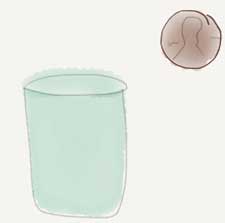Overflowing Surface Tension
Have you ever noticed that you can fill a glass of water higher than the glass itself without spilling? Lets see how far you can push the water before making a mess!
What You Need
- A glass of water
- A saucer
- A stack of coins
What to Do

Place the glass on the saucer and fill the glass of water all the way to the brim. You’ll notice that the water hangs slightly over the top of the glass but doesn’t spill out just yet.
Now, add the coins one at a time to the glass of water, dropping them in rim-first (not face down). Guess how many coins you can add to the glass before the water starts to overflow!
What's Going On?
When we fill the glass with water, we notice right away that it can go over the brim of the glass without spilling. This is because of surface tension. Surface tension holds the water together and acts against what would normally cause the water to fall – gravity – because each molecule of water is attracted to the other water molecules around it. This attraction causes the molecules to stick together and avoid spilling down the side of the glass like gravity would like them to.
Unfortunately, the attraction between the water molecules is only so strong. As we add coins, the amount of water spilling over the edges is getting larger and larger until the water just can’t take it anymore! Gravity is pulling on too many of the molecules for their attraction to keep them up, and the water spills down the side of the glass.
Test It!
Try adding soap to the water. What do you notice about the amount of coins you can add before the water spills? How does soap affect surface tension?
- Aliya Merali














